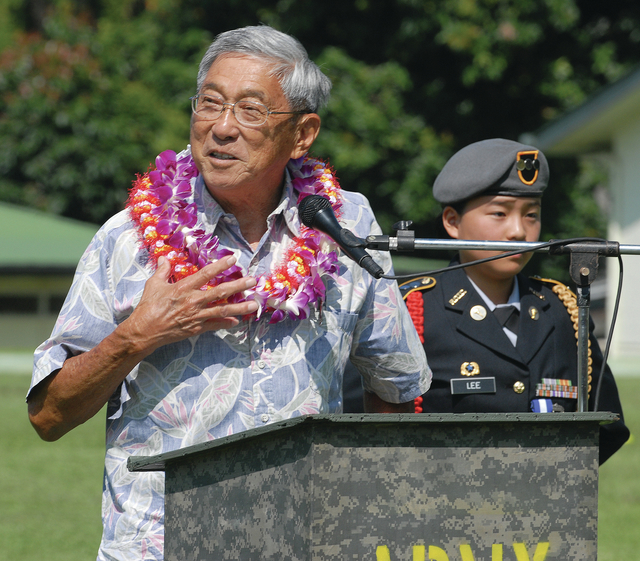KAILUA-KONA — It could be a symbol of unity, a structure that represents mankind’s desire to learn atop Mauna Kea. ADVERTISING KAILUA-KONA — It could be a symbol of unity, a structure that represents mankind’s desire to learn atop Mauna
KAILUA-KONA — It could be a symbol of unity, a structure that represents mankind’s desire to learn atop Mauna Kea.
But should the Thirty Meter Telescope come to fruition, telescope supporters will need to be more understanding of those who don’t want to see the project built atop a mountain they hold sacred.
“You have to change your way of how you approach the messenger,” told a room full of Rotary Club of Kona Sunrise members Wednesday morning at Humpy’s Big Island Alehouse in Kailua-Kona. “It’s a simple statement of, ‘We were wrong. We will be better.’ That’s where we must go.”
One should put themselves in a project opponent’s shoes, Kim told the breakfast crowd. Instead of just saying they understand where that side is coming from, truly learn about history and why one would hold the mountain sacred.
“It’s a special gift to the people of this world,” Kim said of the mountain on which the state-of-the art telescope was slated for construction before protests and a court ruling eventually postponed it.
“When you use this gift, please remember that 99 percent of the people on this island, when they look at Mauna Kea, it’s not as a place of science, they look at it because, some for the majesticness of its beauty, but for many, it’s part of their soul.”
Kim, a former two-term mayor and Civil Defense Administrator who won the mayoral election in the August primary election, said he was speaking to the group from his own personal view, not as mayor-elect or representing the county. He did touch on the mayor’s post, saying he’ll hawk-eye the budget once he gets into office and joked about the Rotary’s speaking guidelines that dissuade speakers from touching on politics.
“What the hell they invite me for,” he said.
But the message was mostly Mauna Kea.
Since Kim won his seat, he’s met with six different groups, representing project stakeholders from France, China, United States, India and Japan — people who have contributed $170 million to see the TMT through.
His message to them was the same: Understanding and communication.
Kim relayed one story where he was talking to an invested party about the telescope when he asked how much that person knew about why some protesters — who hold the mountain sacred and see it as a place of historic significance where ancestors are buried — were protesting. Specifically, Kim asked the party how much they knew about the State Historic Preservation Divison’s Burial Council.
Not much, the party said.
“That’s the problem,” Kim said. “You’re telling them you understand and you don’t know about the sacred ground, the people’s heritage.”
The burial council came to be in the late 1980s after a bulldozer working to renovate a major hotel on Maui unearthed 900-1,000 Hawaiian graves, Kim said. Think of how much revered sites have been disturbed before that? Queen Kaahumanu Highway was built in the 1970s, most all of Kona before the 1980s, too.
“You don’t know how this offended a culture?” Kim said he told the person. “If you want to proceed on where we go from here to there — to create a very beautiful symbol of world peace of world togetherness, a quest for knowledge to make us a better people — then you better learn.”
Now, he said, imagine the shoe was on the other foot. Cowboy boots, in the case of Kim, who said that’s all he wears because that’s all he owns. But the message was the same.
“I want you to put yourself in that position. This is your heritage,” he said. “This isn’t about Mauna Kea, this is symbolic of our total disrespect, disregard and on how we’re treated, a culture, a past.”
The $1.4 billion project is currently in a contest case hearing in Hilo. The Supreme Court ruled the petitioners’ due process rights were violated because the Board of Land and Natural Resources voted in favor of granting the project a land use permit for Mauna Kea before the first contested case was held, prompting a do-over of the quasi-judicial hearing.
Regardless of what happens in court, the sides will need to come together, Kim said. With better understanding, which includes learning more about Hawaiian history, the rift can mend. And, with good fortune, he said, the project will be built and represent the ideals of unity.
“A symbol on the mountain,” Kim said, that “everyone can see and every person who comes to this island can see a symbol of mankind, of working together, in the quest for knowledge, a quest for knowledge to make us a better people and better stewards of this island.”



